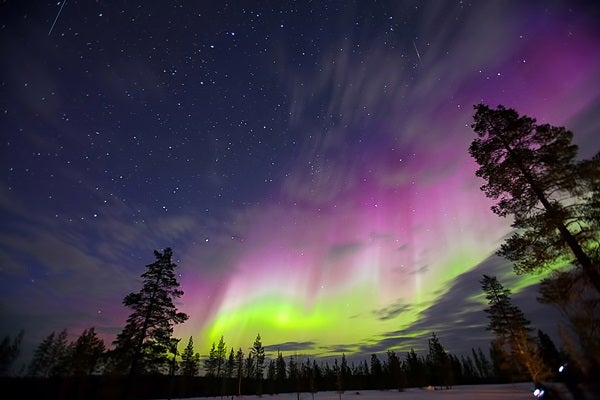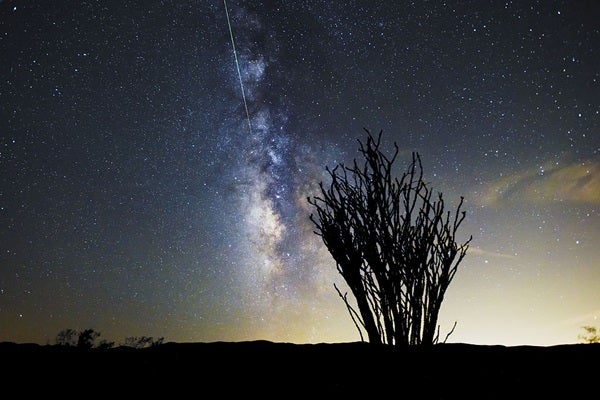Evenings this week are great times to explore the constellation Sagittarius the Archer. This star group lies due south and at peak altitude between 10 and 11 p.m. local daylight time, well after the last vestiges of twilight have faded away. The brightest stars within the constellation form the shape of a teapot — a distinctive asterism once you’ve found it — though it’s misshapen this year with Saturn appearing just to the north. The central regions of the Milky Way pass through Sagittarius, so it’s always worth exploring the area through binoculars or a telescope.
The Moon reaches perigee, the closest point in its orbit around Earth, at 2:07 p.m. EDT. It then lies 222,500 miles (358,078 kilometers) away from us.
Saturday, August 11
New Moon occurs at 5:58 a.m. EDT. At its New phase, the Moon crosses the sky with the Sun and so remains hidden in our star’s glare. At least, that’s what it will do for much of the world’s population. But if you happen to live in northern Canada, northern Europe, or parts of Asia, you can watch the Moon pass in front of the Sun and cause a partial solar eclipse. From Beijing, the Moon covers one-third of our star’s diameter just before sunset. Remember that when viewing the Sun during a partial eclipse, you need to protect your eyes with a safe solar filter.
Sunday, August 12
The annual Perseid meteor shower reaches its peak tonight under perfect conditions. The shower not only produces lots of “shooting stars” — up to 110 per hour under optimal circumstances — but it does so with the Moon out of the sky. The best views will come in the predawn hours of Monday morning when the shower’s radiant — the spot on the border between Perseus and Cassiopeia where the meteors appear to emanate — climbs highest. To see the most meteors, observe from a spot far removed from the lights of the city.
Assuming you watch the Perseid show this morning, don’t pack up when twilight starts to paint the sky. About 45 minutes before the Sun comes up, look for a bright object hovering just above the horizon in the east-southeast. This is the night sky’s brightest star, magnitude –1.5 Sirius in the constellation Canis Major. From mid-northern latitudes, the luminary climbs some 4° high a half-hour before sunrise and should stand out if you have a clear and unobstructed horizon. The return of Sirius to the predawn sky was an occasion for celebration in ancient Egypt. Around 3000 B.C., this so-called heliacal rising of Sirius heralded the coming flood of the Nile River, an event upon which agriculture — and all life in Egypt — depended.
While the brightest star hangs low in the east before dawn, the brightest planet lurks low in the west after sunset. Venus dazzles at magnitude –4.4, nearly 15 times brighter than Sirius. Pay particular attention to Venus this evening, when a 10-percent-lit crescent Moon appears 10° to its right.
Tuesday, August 14
Although Jupiter reached opposition and peak visibility more than three months ago, it remains a stunning sight from evening twilight until it sets after 11 p.m. local daylight time. Jupiter shines at magnitude –2.0 and dominates the southwestern sky as night falls. The gas giant resides among the background stars of Libra the Scales; this evening, it passes just 0.6° due north of Zubenelgenubi (Alpha [α] Librae). If you view the planet through a telescope tonight, its disk spans 36″ and displays spectacular cloud-top detail.
If you thought the Moon and Venus made a pretty pair yesterday evening, the view tonight should be even better. The planet hangs 7° below the crescent Moon, which now appears 18 percent illuminated.
Wednesday, August 15
Comet 21P/Giacobini-Zinner is living up to expectations, currently glowing between 8th and 9th magnitude among the background stars of Cassiopeia the Queen. To see it well, you’ll need to observe from a dark-sky site through a 4-inch or larger telescope. Although this region never sets from north of 30° north latitude, it climbs highest before dawn. Astroimagers should be sure to target the comet from now until Saturday morning as it passes slightly north of the photogenic Heart and Soul nebulae (IC 1805 and IC 1848, respectively).
Thursday, August 16
Mars reached its peak during the last week of July, but it remains a glorious sight this week. The Red Planet appears low in the southeast as darkness falls and grows more prominent as the evening wears on and it climbs higher. By 11 p.m. local daylight time, it stands about 25° high in the south against the backdrop of stars in southwestern Capricornus. The world shines at magnitude –2.5, making it the second-brightest point of light in the night sky after Venus. When viewed through a telescope, the planet’s ocher-colored disk spans 23″. The global dust storm that marred views at opposition appears to be waning, and patient observers should be able to spot some surface details.
Venus lies 46° east of the Sun today, its greatest elongation for this evening apparition. You might think the planet would likewise reach peak altitude today, but you’d be wrong — Venus stands only 7° high an hour after sunset. The problem is the ecliptic, the apparent path of the Sun across the sky that the planets follow closely, makes a shallow angle to the western horizon after the Sun goes down in late summer. How much difference does this make? Venus stood more than twice as high in early June when it was only 35° from the Sun. Still, the planet shows some distinct advantages over its late spring appearance. Not only is it brighter now, at magnitude –4.5, but it also looks more pleasing through a telescope. This evening, Venus’ disk spans 24″ and appears half-lit.
A nearly half-lit Moon lies just 7° to Jupiter’s upper left this evening. The two make an attractive pair from evening twilight until the planet sets shortly after 11 p.m. local daylight time.
Saturday, August 18
First Quarter Moon arrives at 3:49 a.m. EDT. Our satellite won’t rise until around 2 p.m. local daylight time, however, so observers in the Americas won’t see it precisely half-lit. As darkness falls this evening, the Moon appears 58 percent illuminated and resides some 10° to the upper right of the 1st-magnitude star Antares.
Sunday, August 19
Saturn reached its peak more than a month ago, when it appeared opposite the Sun in the sky, and our view of the ringed planet remains magnificent. It appears against the backdrop of northern Sagittarius, a region that climbs highest in the south around 9 p.m. local daylight time. Saturn continues to shine brightly, too, at magnitude 0.3. When viewed through a telescope, the planet’s 18″-diameter disk is surrounded by a dramatic ring system that spans 40″ and tilts 27° to our line of sight.












